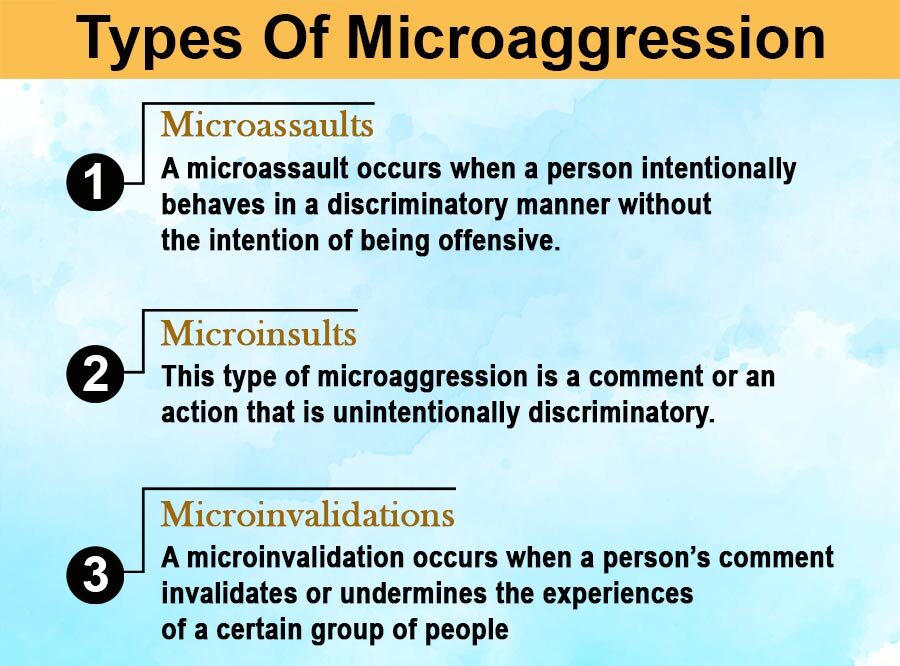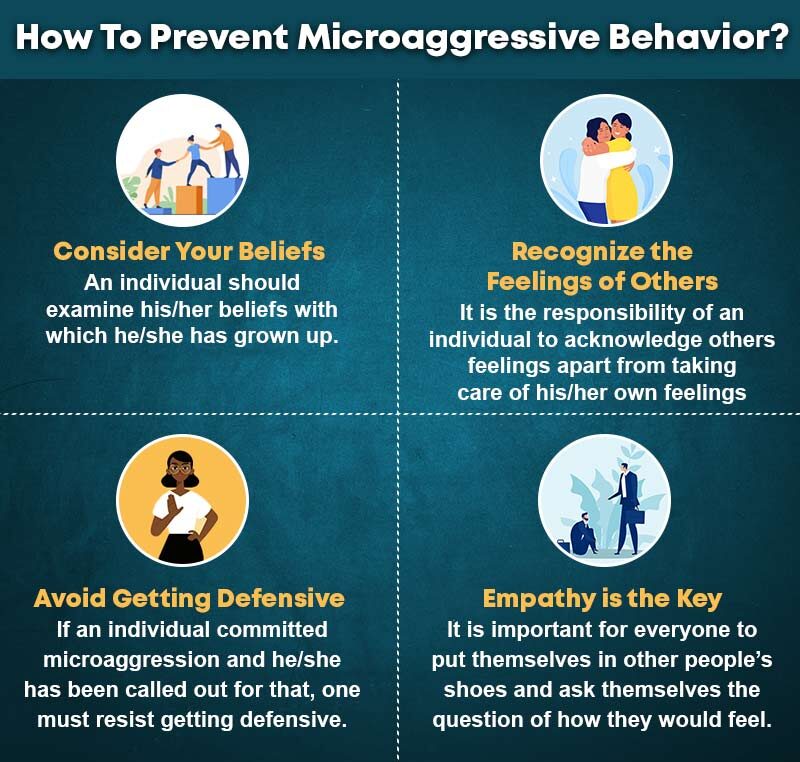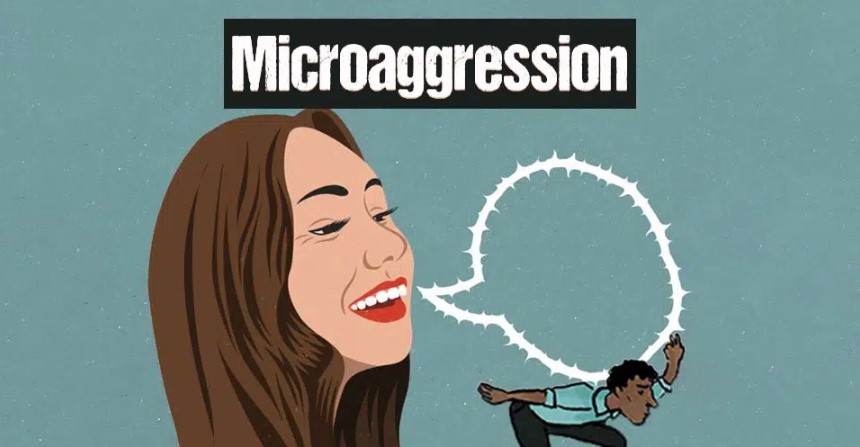Microaggression is defined as the common subtle interactions, comments, or behaviors that express negative attitudes, prejudice or hostility toward marginalized groups.
What Is Microaggression?
Racial microaggression is primarily an everyday experience of racism. It refers to an attitude that is defined by a subtle, often unintentional, form of prejudice. It is a form of expression where rather than an obvious declaration of racism or sexism, it takes the shape of an offhand comment, a carelessly painful joke, or a pointed insult. A 2013 study [mfn] Wong, G., Derthick, A. O., David, E. J., Saw, A., & Okazaki, S. (2014). The What, the Why, and the How: A Review of Racial Microaggressions Research in Psychology. Race and social problems, 6(2), 181–200. https://doi.org/10.1007/s12552-013-9107-9 [/mfn] explains the phenomenon as “subtle insults (verbal, nonverbal, and/or visual) directed toward racial minorities, often automatically or unconsciously. They are hidden in everyday interactions and the undetectable tendency helps to widen the gap of racial realities.”
A study [mfn] Lilienfeld, S. O. (2017). Microaggressions: Strong Claims, Inadequate Evidence. Perspectives on Psychological Science, 12(1), 138–169. https://doi.org/10.1177/1745691616659391 [/mfn] explains microaggressions as subtle snubs, slights, and insults aimed at minorities, as well as women and other historically discredited groups, that implicitly communicate or at least engender hostility. When such comments are compared with overly prejudicial comments and acts, they commonly exhibit themselves to be less direct, although no less pernicious forms of racial bias. Few would debate that such remarks, if not malicious, are almost certainly callous.
Understanding Microaggression
Microaggressions are verbal and behavioral exchanges, sometimes subtle and covert, that send denigrating messages to people of color. According to a 2017 study [mfn] Keith, V. M., Nguyen, A. W., Taylor, R. J., Mouzon, D. M., & Chatters, L. M. (2017). Microaggressions, Discrimination, and Phenotype among African Americans: A Latent Class Analysis of the Impact of Skin Tone and BMI. Sociological inquiry, 87(2), 233–255. https://doi.org/10.1111/soin.12168 [/mfn] , such phenomena are covert & subtle behavioral and verbal exchanges targeted at people of color to belittle them. The researchers of the study explain “These race-based interactions, including slights, exclusions, avoidance, and unfair treatment, can be stressful, demoralizing and, more importantly, threaten mental health and physical health.”
Racial and cultural insensitivities are prevalent in contemporary America, including college campuses. It must be noted that such prejudice at times exhibits itself in subtle and indirect ways and in current times, these have received short shrift in psychological research. It has been observed that in 2008, 4% to 6% of Americans admitted in a national poll that they would be unwilling to vote for an African American candidate as president, and this figure may be an undervalue, given the social undesirability attached to admissions of racism.
For example, a white manager may state that an Asian American employee speaks English well or a white student might ask about the origin of an Indian American student. In both these examples, while the white individual may not have the intention to offend the person of color, however, the comment still will remind the person of color that they are not fully accepted or trusted in the white community. Such experiences of microaggression on a daily basis can result in stress. The experience can be typically unsettling as the targeted person may strive to understand if the comment was intentional and how to respond.
History Of Microaggression
According to research [mfn] Lilienfeld, S. O. (2017). Microaggressions. Perspectives on Psychological Science, 12(1), 138-169. https://doi.org/10.1177/1745691616659391 [/mfn] ”the term microaggression was first coined by Harvard University psychiatrist Chester Pierce in 1970 to describe seemingly minor but damaging put-downs and indignities experienced by African Americans”. Pierce had also written that every Black person must understand the ‘offensive mechanisms’ used by the collective White society via increasing pro-racist microaggressions, which keeps him psychologically accepting of the disenfranchised state. In the next 37 years, a few widespread publications had referred to such actions, especially in regards to racism between Whites and African Americans. It was not until 2007, however, that the concept began to penetrate the academic mainstream.
In an influential publication in the American Psychological Association’s flagship journal, American Psychologist, Derald Wing Sue and his coauthors presented the notion of microaggressions to the broader psychological community. There the concept was defined as a “brief and commonplace daily verbal, behavioral, or environmental indignities, whether intentional or unintentional, that communicate hostile, derogatory, or negative racial slights and insults toward people of color”. According to Sue et al., microaggressions necessarily lie in the eye of the beholder, whereby the targeted person must understand whether it has occurred at all.
He also states that these are pernicious, more so because they are usually vague and the victims get trapped in the catch. It is because they are unsure whether discrimination was implied through the expression aimed at them, thus putting the recipient often in a no-win situation. Additionally, if the victim says nothing, they risk becoming resentful while encouraging further racist comments in the future from the same person. Again, if the victim ends up raising his/her voice, the person passing the comment may deny having engaged in prejudice and accuse the victim of being hypersensitive or paranoid. As a consequence, recipients may become reasonably reluctant to call out deliverers on future microaggressions.
Different Forms Of Microaggression

According to a study, the concept or the actions can be in the form of verbal comments (e.g., subtle racial slights), behavioral (e.g., ignoring minority individuals), or environmental decisions (e.g., naming buildings on a college campus after a White personality). Here are the definitions of the different forms.
1. Verbal
It is performed via a comment or question that is hurtful or defaming to a certain marginalized or minority group of people. For example, saying, “You’re so smart for a woman” is a form of verbal microaggression.
2. Behavioral
It occurs when someone acts in a way that is painful or prejudiced against a certain group of people. For example, when a bartender ignores a transgender person and instead, serves a cisgender person (someone whose biological sex matches their gender identity) first, it defines behavioral microaggression
Read More About Behavioral Economics Here
3. Environmental
It occurs via subtle discrimination within society. One example, when the buildings in a college campus are named only after renowned White people, it is a form of environmental microaggression.
Types Of Microaggression

According to a study, psychologist Derald Wing Sue and his colleagues had classified microaggression into three different categories. These are:
1. Microassaults
A microassault occurs when a person intentionally behaves in a discriminatory manner without the intention of being offensive. A study defines microassaults as an ”overt form of discrimination” in which the discriminator deliberately behaves in a prejudiced way, but do not intend to offend someone or may think that their actions are not noticed or harmful. These types of events are similar to the “old-fashioned” discrimination that existed in earlier times but different in that people may not openly proclaim their biases.
2. Microinsults
This type of microaggression is a comment or an action that is unintentionally discriminatory. A study states that ”microinsults are statements or behaviors in which individuals unintentionally or unconsciously communicate discriminatory messages to members of target groups”. For example, a person might say to an Asian American that he/she “speaks good English” as a compliment. However, this statement can also be interpreted as an offensive statement implying that Asian Americans do not speak English clearly.
3. Microinvalidations
A microinvalidation occurs when a person’s comment invalidates or undermines the experiences of a certain group of people. A study states, ”microinvalidations are characterized by communications that exclude, negate, or nullify the psychological thoughts, feelings, or experiential reality of a person of color”. These are verbal statements that contradict, negate, or weaken the truths of people belonging to various target groups. For example, when a white person tells a person of color that ”racism does not exist”, she or he is ”invalidating and denying” the person of color’s racial reality.
A study states that Sue et al. had reported that microinsults and microinvalidations are more detrimental to mental health than microassaults, given their greater uncertainty followed by their heightened potential to place recipients in a catch.
Examples Of Microaggression
Most of us are victims of microaggressions without our knowledge. Individuals may target others with microaggressions in regards to their race, sexual orientation, gender, class, religion, disability, mental health, weight, or age, among other factors. In 2018, Kansas State University in Manhattan had conducted a study [mfn] Yang, Y., & Carroll, D. W. Gendered Microaggressions in Science, Technology, Engineering, and Mathematics. ERIC – Education Resources Information Center. https://files.eric.ed.gov/fulltext/EJ1174441.pdf [/mfn] catering to workplace microaggressions. The researchers had found that 73% of women working in the fields of science, technology, mathematics, or engineering have experienced at least one form of sexual objectification.
Some other examples of microaggressions are as follows.
- Approaching someone as a second-class citizen owing to their gender, race, or sexual orientation.
- Praising a person for their English, who is born and raised in the United States, simply because they are not white.
- Telling a thin person to eat more food.
- Making opinions about someone based on their religion, age, or class.
- Underrepresenting different races, sexualities, and disabilities in the media.
- Intentionally not using a transgender person’s preferred pronouns.
- Acting unwillingly to find stereotypical or derogatory sports team names offensive.
- Considering certain people to be more important than others based on their ethnicity, class, or sexuality
- Using old and offensive terminology, such as, “That’s so gay.”
The Harmful Effects Of Microaggressions
Microaggressions can be devastating and stressful to the people who experience them. A study [mfn] Nadal, K. L., Wong, Y., Griffin, K. E., Davidoff, K., & Sriken, J. (2014). The adverse impact of racial microaggressions on college students’ self-esteem. Journal of College Student Development, 55(5), 461-474. https://doi.org/10.1353/csd.2014.0051 [/mfn] states that the effects of racial microaggressions on undergraduate college students have resulted in lower self-esteem. The study also states that such discriminations were especially harmful in work and educational settings.
In another study, researchers have concluded that people who experience such discrimination in regards to their ethnicity, suffer higher levels of depression and trauma. However, the study could not confirm whether it directly causes depression in the participants. Also, a study in India had found that “experiencing invisibility” caused distress for participants who saw themselves as prototypical of the Northeasterners.
How To Respond To Microaggression?
While experiencing microaggression can be stressful, learning to cope with such comments will alleviate anxiety and depression, thus enabling one to focus on other important aspects of life. Here are a few ways to respond to comments or discriminations rationally.
1. Seek Support
One of the most prominent ways to manage our mental health is to make sure that we live amidst and around supportive individuals who will help us to process our experiences. Be it a colleague, a therapist, a family member, or a friend, it is necessary for one to have space where he/she can share the experiences without hesitation.
2. Don’t Internalize Racism
When it comes to microaggression attacking a person’s race, one may feel like to change something about himself/herself to feel more accepted in society. However, one must understand that it is important to stay grounded, and changing anything won’t resolve the problem, as it is not the person but racism is the main issue.
3. Leave the Place When Required
It is important to understand when to leave a scene or a situation and when not. Certain conditions can be challenging, like in the workplace where one won’t be able to leave suddenly. In such situations, it is important to learn to stay away from toxic situations for one’s own mental peace. Psychologist Derald Wing Sue and colleagues had stated that ”deciding the appropriate way to respond to a microaggression can be stressful in itself”. However, an individual can ask himself/herself three questions to decide whether or not to respond to any comment. These are:
- Did this really occur?
- Should I respond to this?
- How should I respond to this?
Coping Strategies For Microaggression
According to another study [mfn] Harrison, C., & Tanner, K. D. (2018). Language Matters: Considering Microaggressions in Science. CBE life sciences education, 17(1), fe4. https://doi.org/10.1187/cbe.18-01-0011 [/mfn] , there are five ways to respond to and mitigate the effects of microaggression.
- First, acknowledging the fact that microaggression has occurred. It is essential to let a person know that you are aware of the issue and that the conceivably harmful situation is being given full consideration.
- Second, approving the negative feelings that can be caused by this is essential. This can support all those individuals who are affected by the negative feelings arising from such actions. It also fosters support for those who are affected by such comments, thereby, eliminating the cognitive load examining whether or not their feelings are valid
- Third, confronting the microaggressive language and making sure to distance from such comments as it has no place in academia.
- Fourth, making oneself ready for anyone affected by this to exhibit that it is an issue and the person takes it seriously.
- Fifth, the victim must meet with the person privately, who initiated the microaggression to make them understand how their language can be harmful to others.
How To Prevent Microaggressive Behavior?

Preventing microaggression from occurring should begin with one person at a time. If an individual finds himself/herself exhibiting microaggressive behaviors, here are a few things to do to avoid it from happening again.
1. Consider Your Beliefs
An individual should examine his/her beliefs with which he/she has grown up. He/she must question to himself /herself whether those beliefs and values at all resonate with one’s personality. Individuals must use this time for self-reflection and evaluate those beliefs that work for them even in their adulthood.
2. Recognize the Feelings of Others
It is the responsibility of an individual to acknowledge others feelings apart from taking care of his/her own feelings. He/she must understand how others feel upon confirming the fact that their feelings matter. Thus, every individual must act mindfully in a day, especially, whenever it comes to saying anything as microaggression might affect those around them.
3. Empathy is the Key
It is important for everyone to put themselves in other people’s shoes and ask themselves the question of how they would feel if they were facing such comments. Thus, by investigating another person’s perspective, one can gain insight into his/her behavior.
Read More About Empathy Here
4. Avoid Getting Defensive
If an individual committed microaggression and he/she has been called out for that, one must resist getting defensive. Instead, the person must act with curiosity and ask questions that can help him/her understand a person’s point of view. The person should not downplay the situation but listen carefully as the other person shares his/her experience.
It must be noted that if microaggression is the center stage, we all play a significant role in responding to and preventing it. This can be done by taking out time to learn, to ask questions, and be responsible for our actions.
Education About Microaggression Is Important
We all have committed microaggression even without our knowledge, at some point in our lives. Think about the time when such casual comments had left you with negative feelings. While addressing such behavior may feel overwhelming initially, however, even small steps may be the key to changing professional culture. Additionally, education about microaggressions is the key to spreading awareness. The increasing awareness about the term and concept will make individuals less defensive when confronted about their behaviors. Also, teaching kids about diversity and equality from an early age will help them to grow up as broad-minded adults.
Microaggression At A Glance
- Microaggression refers to an attitude that is defined by a subtle, often unintentional, form of prejudice.
- Microaggressions are verbal and behavioral exchanges, sometimes subtle and covert, that send denigrating messages to people of color.
- A microassault occurs when a person intentionally behaves in a discriminatory manner without the intention of being offensive.
- Most of us are victims of microaggressions without our knowledge.










Leave a Reply